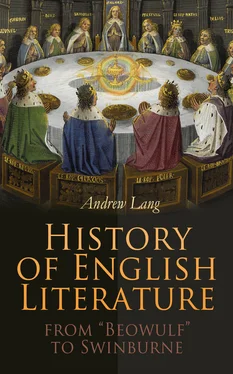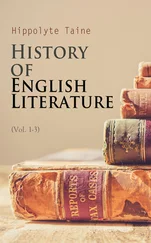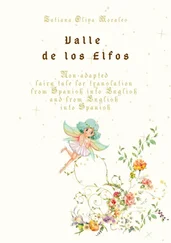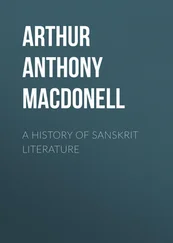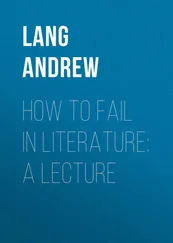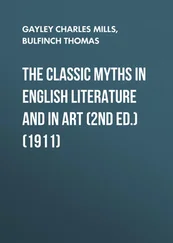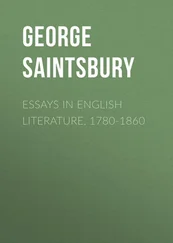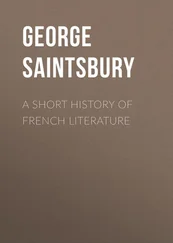O Dowglas, O Dowglas,
Tendir and Trewe!
"Trewe" they had been, to Bruce and to Scotland, but they became the allies, against king and country, of Edward IV and Henry VIII, while "tender" the Douglases never were. The most interesting passage describes the voyage of the good Lord James towards the Holy Land, with the heart of Bruce. In Spain he meets the Saracens in battle, and throws among them the Heart, in its jewelled case—
Amang the hethin men the hert hardely he slang,
Said, "Wend on as thou was wont,
Throw the batell in front,
Ay formost in the front,
Thy foes amang."
There fell the Douglas, above the heart of his king, that was rescued by Logan and Lockhart, and brought back to Scotland; a noble feat of chivalry, nobly told. Here Holland "stirs the blood like the sound of a trumpet".
It may be said of these Scottish poets that while, in initiative and in models they owe almost all to England, their long and desperate war with that country gives them a martial fire and spirit to which the English poetry of the time furnishes no rival. Laurence Minot does not stir the blood!
Gawain Douglas was of the family of the Red Douglases, Earls of Angus, who rose on the ruin of the turbulent Black Douglases, of the House of Bruce's good Lord James, when they failed in their alliance with England against the Crown of Scotland. The Red Douglases also rose high, and had their own feud with the Crown and alliance with or servitude to Henry VIII and the Protestant cause. Gawain was a younger son of the Earl of Angus called Bell the Cat, who hanged the artistic favourites of James III. As an old man he was present at Flodden (1513) where James IV died so gallantly, and his grandson, now Earl of Angus, married Dunbar's "Rose," Margaret Tudor, widow of James IV. Gawain himself, born about 1473 or 1474, was educated at St. Andrews University, took orders, and, being of a powerful House, received rapid clerical promotion.
His poems were written in the peaceful and prosperous years of James IV, between 1501 and 1513, the date of Flodden and of the completion of Gawain's translation of the "Æneid" of Virgil. His earlier works "The Palice of Honour" and "King Hart," are merely rhymed allegories after the manner of the unceasing "Roman de la Rose," and have no special interest. What is true about one of these belated last allegories is true of another: they are no longer to be read for mere literary pleasure. In his "Æneid," Douglas introduces original prologues to the books of the "Æneid," rather in the manner of Scott's poetical epistles between the cantos of "Marmion". He describes winter, spring, and summer in Scotland. He criticizes, not unfavourably, the theology of Virgil, whom the Middle Ages regarded, now as a magician (like Ovid among the Italian peasantry to this day), and now as an inspired prophet of the coming of Our Lord. He attacks Caxton for printing a translation of Virgil, not from the original Latin, but from a French version. His criticism of Caxton is full of detail, and severe. He himself is "bound to Virgil's text," and he does not treat it, as a rule, with the licence of Chapman when rendering Homer into English verse; but Gawain remarks, truly, that sometimes of one word he must make three, must occasionally expand in exposition, and add, in colouring.
Sum tyme I follow the text als neir I may,
Sum tyme I am constreinit are uther way.
His remarks on the task of the translator show considerable reflection. On comparing the poem with the Latin it seems more close in sense to the great untranslatable original than might have been expected in an uncritical age and country. It is the first attempt in our language at the rendering of a great ancient classic, and, as such, looks forward to the new times, and to the Renaissance which, in Scotland, was mainly confined to Biblical criticism.
After Flodden, Gawain was immersed in politics, and in a long and futile struggle to obtain, through English influence, the Archbishopric of St. Andrews. For this he fought a triangular duel (nor were the weapons of the flesh unused), with Hepburn, the Prior, and Forman, a clerical diplomatist, who was successful. Gawain obtained the petty Bishopric of Dunkeld, on the Tay, and died when on a political mission to London (1522). Gawain is almost the only Scottish example of a nobleman and a Churchman, in his age, distinguished for devotion to literary scholarship. There are a number of Scots poems, of this date, such as "Christ's Kirk on the Green" and "Peebles at the Play" (the best of them), which show much command of lively metre and rude descriptive powers where rustic merriment and horseplay are to be painted. But their dialect is usually uncouth, and they are only appreciated by special students.
The most popular of the old Scottish poets was not so poetical as Henryson, but gave pleasure by his genial character, his extremely coarse humour, and his attacks on the Churchmen and on abuses in the State. This author, Sir David Lyndsay, was born, perhaps at his family place, the Mount, in Fife, about 1490. His name "Da. Lyndsay" (if it be his) appears in the register of St. Andrews University besides that of the man whom he hated so much, and attacked in verse after his murder, the great Cardinal Beaton. By 1511, Lyndsay was a page at Court, and acted in a play at Holyrood. In 1512, Lyndsay was Master of the Household, or chief attendant of the infant Prince, later James V. He was present when the apparition described in "Marmion" gave a warning, in church, to James IV, just before Flodden, and told Lyndsay of Pitscottie, the amusing chronicler, that he tried to arrest the figure "but he vanished away as if he had been a blink of the sun or a whiz of the whirlwind". Till 1522 his chief business was to teach and amuse the boy, James V;
I bore thee in mine arm
Full tenderly,
and, later, told him fairy tales such as the story of the Red Etin, or disguised himself as "the grisly ghost of Guy".
About 1528 Lyndsay wrote "The Dreame" (the usual allegorical dream), in 1529 he was made chief herald, "Lord Lyon King of Arms," and as such went on many foreign embassies. In 1539-1540 his great play, "The Satire of the Three Estates," was acted before the Court; it is the only early Scottish drama that survives. There are two Parts, and three interludes full of matter wonderfully coarse. The play is all in favour of reforms, and is full of the satire of the Churchmen and pleadings for the poor which ensured its popularity. There are some seventy characters, most of them allegorical personages. The King delighted in the satire, and as Lyndsay attacked the vices of the clergy and the Pardoners, not the doctrines of the Church, he ran no risk of martyrdom. The verse is in many forms and different sorts of stanzas, in rhyming couplets of eight syllables, or of ten or more.
After James's death and the murder of Cardinal Beaton, Lyndsay wrote a poem, "The Tragedy of the Cardinal" in which his ghost accuses himself of many sins and crimes, and is sure that Boccaccio would write "my tragedie," if Boccaccio were still alive. Lyndsay died early in 1555. His most popular poem, probably, was a good-humoured romance, "Squire Meldrum," about the fighting adventures, at home and abroad, of a young Fife laird of the period. He wrote many other things, humorous or grave, admonitions to the King, and a reply to a "Flyting" or scolding, of the King against him, in verse; unluckily the Royal lampoon is lost. A Lament for James's first wife who died young; a very humorous set of verses on the King's dog; and a "Dialogue between Experience and a Courtier," with shorter pieces, grave or gay, make up Lyndsay's contribution to the literature of his country. They are full of historical hints, but, merely as poetry, are now seldom read, as Henryson may be read, for pleasure. The Reformation, breaking out in 1559, distracted men's minds from secular literature, to which, for more than a century, Scotland contributed nothing of real importance except the "History of the Reformation" by John Knox, the Reformer. This work is written in such English (not Scots) as Knox could command, for in origin it was meant to be read in England, and to justify the proceedings of the Reformers. It is partly derived from memory of the events and the memory is sometimes strangely inaccurate. Public documents are inserted at full length, in one case with some lack of candour, and actions are denied which, later, were acknowledged. The book, as history, needs to be cautiously studied, but as a picture of the men and women of the age, especially of Knox himself and Queen Mary, it is most vivacious, and may be read with interest and amusement. Knox's other works, theological, epistolary, and political, were written to meet the needs of the moment, and are of little value except to historians and students of the career and character of the author.
Читать дальше
